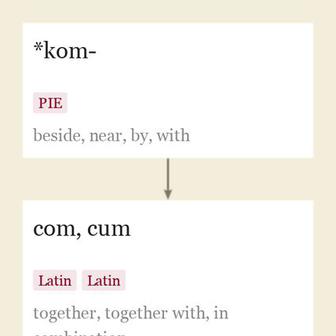couture (n.)
"时尚裁缝或设计"(缩写为 haute couture),1908年,来自法语 couture,字面意思为“裁缝、缝纫”,源自12世纪的古法语 costure,从通俗拉丁语 *consutura 而来,源自拉丁语 consuere 的过去分词形式,意为“缝合”,由 com 的同化形式“和,一起”(参见 com-)和 suere “缝合”(来自 PIE 词根 *syu- “绑,缝”)组成。被用作“女装设计师”的集体术语。起初是英语中的法语词汇; 在1940年代之前一直使用斜体字。
couture 的相关词汇

这是一个单词构成元素,通常表示“与,一起”,源自拉丁语 com,是古典拉丁语 cum 的古老形式,意为“一起,与,结合”,源自原始印欧语言 *kom- 的“旁边,附近,与”的意思(与古英语 ge- 、德语 ge- 类似)。在拉丁语中,该前缀有时被用作一种强调语气的方式。
在元音和清辅音前,缩写为 co-; 在 -g- 前,同化为 cog- 或 con-; 在 -l- 前,同化为 col-; 在 -r- 和 -v-, 前,同化为 cor- 和 con-; -c-, -d-, -j-, -n-, -q-, -s-, -t- 之前,也被同化为 con-。这种同化非常普遍,以至于经常被用作正常形式。
syū-, 也作 sū:-,指原始印欧语言的词根,意为“绑,缝。”
它构成或成为以下词语的一部分: accouter; couture; hymen; Kama Sutra; seam; sew; souter; souvlaki; sutra; sutile; suture。
这个词根的假设来源和证据包括:梵文 sivyati “缝合”, sutram “线,细绳”; 希腊语 hymen “薄皮,薄膜”, hymnos “歌曲”; 拉丁语 suere “缝合,缝在一起”; 古教会斯拉夫语 šijo “缝纫”, šivu “缝合线”; 拉脱维亚语 siuviu 、siuti “缝纫”, siuvikis “裁缝”; 俄语 švec “裁缝”; 古英语 siwian “缝合,缝补,修补,编织在一起。”
"男性裁缝或时装设计师",1885年,最初作为法语词汇在英语中出现,来自法语 couturier,源自 couture "缝纫,制衣"(参见 couture)。Couturière "女性裁缝"在英语中的记载始于1818年。
THE couturier—the bearded dressmaker, the masculine artist in silk and satin—is an essentially modern and Parisian phenomenon. It is true the elegant and capricious Madame de Pompadour owed most of her toilets and elegant accoutrements to the genius of Supplis, the famous tailleur pour dames, or ladies' tailor, of the epoch. But Supplis was an exception and he never assumed the name of couturier, the masculine form of couturière, "dress-maker." That appellation was reserved for the great artists of the Second Empire, Worth, Aurelly, Pingat, and their rivals, who utterly revolutionized feminine costume and endeavored to direct it in the paths of art, good taste, and comfort. ["The Parisian Couturier," Lippincott's Magazine, October 1885]
couturier ——有胡须的裁缝,丝绸和缎面的男性艺术家——是一个基本上现代的、巴黎的现象。的确,优雅而任性的庞巴度夫人大部分的服装和精致的装备都归功于 Supplis 的天才,他是那个时代著名的 tailleur pour dames,或者说女士的裁缝。但 Supplis 是个例外,他从未自称为 couturier,这是 couturière "裁缝"的男性形式。这个称呼被保留给了第二帝国的伟大艺术家们,Worth,Aurelly,Pingat,以及他们的竞争对手,他们彻底改变了女性服装,并努力引导它走向艺术,品味和舒适的道路。["巴黎的 Couturier," Lippincott's Magazine, 1885年10月]